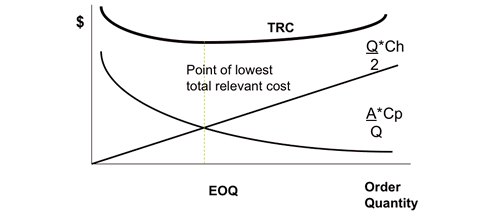Theoretical Paper
- Computer Organization
- Data Structure
- Digital Electronics
- Object Oriented Programming
- Discrete Mathematics
- Graph Theory
- Operating Systems
- Software Engineering
- Computer Graphics
- Database Management System
- Operation Research
- Computer Networking
- Image Processing
- Internet Technologies
- Micro Processor
- E-Commerce & ERP
Practical Paper
Industrial Training
Inventory Control Determination of EOQ
ECONOMIC ORDER QUANTITY (EOQ) MODEL
The economic order quantity (EOQ) is the order quantity that minimizes total holding and ordering costs for the year. Even if all the assumptions don’t hold exactly, the EOQ gives us a good indication of whether or not current order quantities are reasonable.
What is the EOQ Model?
What Would Holding and Ordering Costs Look Like for the Years?
Total Relevant* Cost (TRC)
Economic Order Quantity (EOQ)
EOQ Formula
Same Problem
What is the EOQ Model?
Cost Minimizing “Q”
Assumptions:
Relatively uniform & known demand rate
Fixed item cost
Fixed ordering and holding cost
Constant lead time
(Of course, these assumptions don’t always hold, but the model is pretty robust in practice.)
What Would Holding and Ordering Costs Look Like for the Years?

A = Demand for the year
Cp = Cost to place a single order
Ch = Cost to hold one unit inventory for a year
Total Relevant* Cost (TRC)
Yearly Holding Cost + Yearly Ordering Cost ,

Economic Order Quantity (EOQ)

EOQ Formula

Same Problem
Pam runs a mail-order business for gym equipment. Annual demand for the TricoFlexers is 16,000. The annual holding cost per unit is $2.50 and the cost to place an order is $50. What is the economic order quantity?


